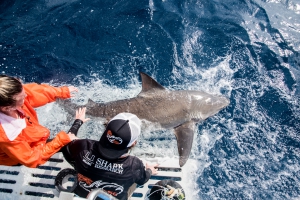Overview
It is now commonly accepted that shark populations globally are experiencing varying levels of decline due to various anthropogenic impacts. Florida and the Caribbean are ideal locations to conduct research on the status of temperate and tropical elasmobranch species, largely due the high species diversity and relative abundance. These waters also provide extensive habitat for coastal and semi-pelagic sharks to use are birthing, nursing, and juvenile feeding grounds. Moreover, Florida’s connectivity to the Gulf of Mexico, Caribbean, and Atlantic Ocean provides various migratory gateways for larger adults. Despite its biological importance, these areas indeed host numerous, growing threats from recreational and commercial fisheries. Much is still to be learned on the life histories, movements, and distribution of predators in this region, while determining which populations and species require heightened conservation attention. Therefore, this work aims to quantify the diversity and richness of species in these areas, while providing a comprehensive evaluation of the impacts from fishing, habitat degradation, and resource loss facing these populations and their habitats.
Groundwork
Ecological risk assessment is an increasingly popular tool that can be used to link scientific research and policy-making decisions. In an effort to conduct these ecosystem-wide analyses, this project incorporates various disciplines and methodologies, taking a fully empirical approach to triaging species for conservation.
Methodology
- Standardized surveys for studying the distribution and structure of shark species in Southern Florida and the Northwestern Caribbean
- Physiological and Behavioral stress research for the shark response to fishing pressure
- Feeding specialization of a framework of species determining trophic structure of the representative species
- Tracking and monitoring the movements and site-fidelity of all species through satellite tagging and acoustic telemetry
Gallagher AJ, Kyne PM, Hammerschlag N. 2012. Ecological risk assessment and its application to elasmobranch conservation and management. Journal of Fish Biology, 85(5): 1727-1748


 We hope to provide detailed information on the vulnerabilities of these animals in the subtropical Atlantic. We know they are threatened, but this data is needed to better inform the proper management of these species. This is of particular importance to places such as the Bahamas, which represents one of the last ecological strongholds for sharks worldwide. Finally, we hope to triage species for the appropriate conservation action.
We hope to provide detailed information on the vulnerabilities of these animals in the subtropical Atlantic. We know they are threatened, but this data is needed to better inform the proper management of these species. This is of particular importance to places such as the Bahamas, which represents one of the last ecological strongholds for sharks worldwide. Finally, we hope to triage species for the appropriate conservation action.
